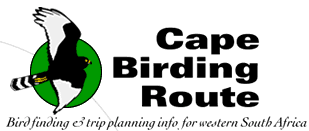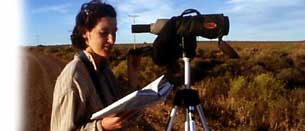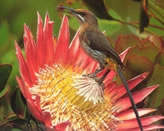Select
Specials: Cape Peninsula
African Penguin
Formerly
known as the Jackass Penguin because of its loud, peculiarly
braying call, this charismatic bird has acted as a mascot
species for marine conservation in South Africa. Although
two mainland colonies have recently formed near Cape Town
(see pp.24 and 62), African Penguins typically breed on offshore
islands from Namibia to the Eastern Cape Province. The past
century has seen a shattering 90 per cent loss of the population,
which now stands at a steadily declining 160 000. Old enemies
have been replaced by new ones: egg collecting and guano harvesting
once took a heavy toll on the breeding colonies; today their
main food source, pilchards, is threatened by over-fishing.
Oil spills also cause devastating losses, although the South
African National Foundation for the Conservation of Coastal
Birds (SANCCOB) has over the past two decades successfully
rescued and rehabilitated many tens of thousands of oiled
birds (see p.43).
African Black Oystercatcher
Fewer
than 4 800 individuals of this striking endemic still grace
rocky and sandy shores from Namibia to the Eastern Cape Province.
Although it is one of the world’s rarest oystercatcher
species, it is conspicuous on the Cape Peninsula and can easily
be seen at Sea Point (p.31), Kommetjie (p.21) or in the Cape
of Good Hope reserve (p.24). In fact, more than half the world
population occurs within 300 km of Cape Town. The birds’
demise lies in their habit of nesting on exposed beaches:
the superbly camouflaged eggs and young chicks are often trodden
on or driven over. Professor Phil Hockey of the Percy FitzPatrick
Institute of African Ornithology leads a long-term study of
the ecology and conservation of this species.
Knysna Warbler
This
localized endemic, which occurs along the south coast from
Cape Town to the Eastern Cape, is best searched for in the
riverine undergrowth of the forests and thickets of the eastern
slopes of Table Mountain (see Constantia Greenbelts, p.19,
and Kirstenbosch, p.17). There are also good sites at the
Grootvadersbosch Nature Reserve (p.69) and on the Garden Route
(p.117). It is an extreme skulker, though its penetrating,
descending song makes up for its admittedly drab plumage and
secretive habits. Its low, rattling contact calls are rather
less conspicuous, but are often useful in locating it. Stealthy
and mouse-like, it spends much of its time feeding on the
ground, flicking its wings and tail to disturb insects from
the leaf litter. Despite occurring in the city suburbs, its
nest was only discovered as recently as 1960, in the Kirstenbosch
National Botanical Garden.
Cape Sugarbird
There
are just two species of sugarbird, together constituting southern
Africa’s only endemic bird family. Their puzzling evolutionary
relationships continue to perplex scientists, with conflicting
evidence variously suggesting relationships with the starlings,
the sunbirds, or even the Australian honey-eaters. The Cape
Sugarbird is easily seen, conspicuous in distinctive silhouette,
as it perches on the flowerheads of the protea bushes that
are a major element of fynbos vegetation. Local sugarbird
populations fluctuate markedly over the year, with the birds
ranging up to 150 km in search of flowering protea bushes.
Nonetheless, sugarbird-bedecked flowering proteas are found
year-round in the Kirstenbosch National Botanical Garden (p.17);
other good sites are the Cape of Good Hope reserve (p.24),
Sir Lowry’s Pass (p.61) and Swartberg Pass (p.123).
Orange-breasted Sunbird
Another
fynbos endemic, the Orange-breasted Sunbird is primarily a
specialist feeder on the spectacularly diverse, often tubular,
erica (heath) flowers that are a major component of fynbos.
It is often the most abundant species in this habitat, and
is easily located by its characteristically metallic call,
one of the distinctively atmospheric sounds of the rugged,
wind-battered Cape mountains. Sunbirds at Kirstenbosch (p.17)
are often very approachable, but this species is also easily
found at the Cape of Good Hope reserve (p.24), Sir Lowry’s
Pass (p.61), Harold Porter Botanical Garden (p.63), Bain’s
Kloof Pass (p.81), Swartberg Pass (p.123), or indeed any expanse
of mountain fynbos.
Cape Siskin
One
of the trickier fynbos endemics to find during a short visit,
the Cape Siskin is nonetheless often a common bird in its
preferred habitat, which is open, rocky fynbos, usually wind-blown
and not conducive to good views of a small, mobile seed-eater.
Cape Siskins are usually detected as they give their distinctive
tri-syllablic flight call before disappearing over a ridge
in small, nervous flocks. The males’ white-tipped wings
and tail are a good field character. For details of the best
sites, refer to the text on the Cape of Good Hope reserve
(p.81), Bain’s Kloof Pass (p.81), Grootvadersbosch Nature
Reserve (p.70), Harold Porter Botanical Garden (p.63) and
Swartberg Pass (p.123).
|


